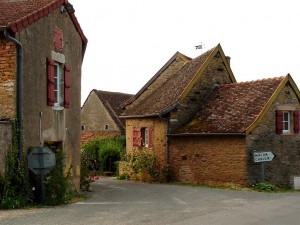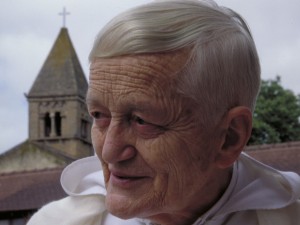I first heard about the Taizé community in early 2009, when a choir director from my church mentioned that a new Taizé choir needed singers. My husband and I love to sing – but we had no idea what the word “Taizé” meant.
After doing a little research, we soon found out the remarkable story. Taizé, it turns out, is a small village in southern France. In 1940, a young Swiss student named Roger Schutz-Marsauche, the son of a Protestant pastor, wanted to be of assistance to those suffering because of WWII. He rode his bike from his home in Geneva to southeastern France, an area unoccupied by the Nazis at the time. He ended up in the village of Taizé where he bought an old house and, before long, was hiding Christian and Jewish war refugees.
Two years later, a retired French officer who was an old family friend warned that his activities had been found out. Soon the Gestapo took over his house in Taizé, but not before the refugees were safely dispersed and Brother Roger, as he came to be called, had returned to Switzerland. For a long time before this he had been drawn to the idea of living a Christ-centered communal life, and it was in Geneva during the next two years that he began a common life with his first brothers. They were able to return to Taizé in 1944, living together in simplicity, celibacy and obedience, assisting the needy that lived in the area and helping to rebuild lives affected by the war. In the years that followed more young men, both Protestant and Catholic, joined their community.
In the 1960s, young people began to visit Taizé. To welcome people and traditions from around the world, the brothers began chanting passages from the Bible, and including prayers and Scripture readings in many languages in their worship times. Taizé music emphasizes simple phrases, usually from the Psalms, repeated or sometimes sung in canon. Services based on this model are now held all over the world, by Christians from many backgrounds – a beautiful sign of unity in the Body of Christ.
Brother Roger led the Taizé community until 2005 when, at the age of 90, he was killed in a knife attack by a mentally ill woman during an evening prayer service. His legacy lives on. The number of visitors to the village of Taizé now numbers in the thousands each year, and communities of brothers from Taizé have formed in many countries, where they live alongside the poor as instruments of God’s love.
Vanessa Miller is a young lawyer in Calgary. A visit to the Taizé community in France left her powerfully affected by the songs, prayers and sense of joy she witnessed there.
“I kept thinking about all the people who were physically unable to attend Taizé services,” says Miller. “I thought about how much they would enjoy the music and feel the peace of Christ.”
After returning to Calgary from eastern Canada, she and Fr. Noel Farman, parish priest at St. Famille Church, began holding monthly Taizé services at Carewest’s Dr. Vernon Fanning Centre, which offers residential care for people of all ages who have severe long-term health concerns. A team of volunteers joined them, to read Scripture, lead prayers and transport residents from their wards to the auditorium.
With support from St. Joseph Church’s music ministry, a choir was also formed – which included my husband and I. Besides the core group who attend regularly, singers and musicians from a variety of churches in Calgary often join our little choir.
On the third Friday of every month at 6:30 p.m., the lights in the auditorium at the Fanning Centre are dimmed, and meditative images of nature and religious art are projected on a screen. Residents, volunteers and choir members gather together. As part of our Taizé service, Scripture is read aloud in a number of languages. My favorite is when Fr. Farman, a Chaldean by birth who hails from Iraq, “sings” Scripture in Aramaic.
Interspersed throughout the prayers, readings and times of silent reflection, we sing Taizé songs together. As the simple melodies and ancient words of adoration and trust become our focus, the worries of the day drift away. We empty ourselves and make room for God. Abilities and disabilities cease to matter.
After the service we always have cookies and juice as we chat with the residents – a time we all treasure. Sometimes a familiar resident won’t show up, and we’ll inquire and find out that he or she has passed away in the weeks since our last visit. For Miller, part of the impetus to start Taizé services at the Fanning Centre was her realization that for many patients, their next step is eternity.
“I thought about their salvation, and that this is another way to share our Lord Jesus Christ and the Gospel with them before they re-locate,” says Miller.
My husband and I both get much, much more out of this monthly experience than we give. On more than one occasion I have been moved to tears by the loving welcome we are given by the residents, and from hearing them sing from their hearts.
 We always leave the Fanning Centre counting our blessings. Everything seems to get put in its proper perspective – that each of us are God’s beloved children, called to be a light to one another. And Christ sings to us, clear as a bell, through His suffering ones.
We always leave the Fanning Centre counting our blessings. Everything seems to get put in its proper perspective – that each of us are God’s beloved children, called to be a light to one another. And Christ sings to us, clear as a bell, through His suffering ones.
To hear Taizé music and find out more about the Taizé community in France and around the world, visit www.taize.fr









